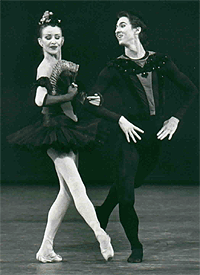Bourrée Fantasque
Choreography:
George Balanchine © The George Balanchine Trust
Music:
Marche Joyeuse (1888); Bourrée Fantasque (1891); Prélude from the opera Gwendoline (1885), Fête Polonaise from the comic opera Le Roi Malgré Lui (The Reluctant King)
Composer:
Emmanuel Chabrier
Premiere:
1949
Duration:
24
Minutes
No. Dancers:
42
Photo © Paul Kolnik

Balanchine had admired Chabrier’s music since discovering it in his early years in France. He knew the pieces he would assemble into the score of Bourrée Fantasque, but waited a long time before he used them to create one of the first works for the newly-formed New York City Ballet. Balanchine was well-known for his wonderful wit as well as an encyclopedic knowledge of dance forms. Here he takes comic aim at many of the conventions that typify classical dance while providing glimpses of such popular dances such as the can-can and tango. This large ballet for 42 dancers is performed in four movements with each of the first three sections having its own principal couple. It culminates in a rousing finale for the entire cast. Critics have praised Bourrée Fantasque for its Gallic style, Russian dance vocabulary, and American dynamism.
Emmanuel Chabrier (1841-1894), the French composer and pianist, is regarded as one of the most inventive nineteenth-century composers, and was a catalyst for French modernism. Ravel deemed him the most influential of French composers, asserting that “his role was as important as Manet in painting.” Best known for his orchestral rhapsody España, his operas comiques and his piano compositions, including Bourrée Fantasque, inspired many French composers. As a musical parodist, he was the forerunner of Satie, Poulenc, and Milhaud.